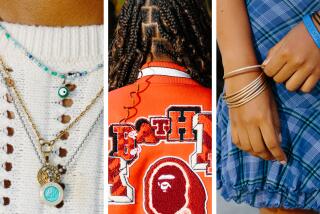Ainât Nothinâ Like the Real Teen
NEW YORK â âPut that damn thing away!â
There may be no more ârealâ moment on television this season than this one, in which a teenage boy relentlessly records an argument heâs having with his harassed mother. Poorly lighted, wobbly, raw, this scene in âAmerican High,â premiering Wednesday on Fox, makes the tantrums, tears, disputes and triumphs in such programming as âThe Real World,â âSurvivorâ and âBig Brother,â not to mention the Republican and Democratic national conventions, look like what they are: contrivances.
âI consider it extremely ironic, if not Orwellian, that those shows are called reality shows, because thereâs nothing particularly real about them,â says R.J. Cutler, executive producer of âAmerican High,â referring to the new wave of so-called prime-time ârealityâ series. âI think they should be called âfabrication TV.â â
âAmerican Highâ follows a group of roughly a dozen teenagers in a suburban Chicago high school through a senior school year, both at home and in class. The footage was shot by two camera crews and by the students themselves, who were given a crash course in filmmaking and then turned loose to shoot their friends, their families and themselves in the form of video diaries (which should make for some fascinating, and at times excruciating, viewing 10 or 20 years down the line). The result is an affecting, often surprising look at what it means to be a teenager these days. And also, not so incidentally, to be a parent.
âIt goes deep into the characters and their situations and decisions and conflicts and relationships and hopes and dreams and obstacles and the way they confront all of those things,â says Cutler, who co-produced âThe War Room,â the celebrated Clinton 1992 campaign documentary. âYou are responding to them the way you respond to characters in a drama, where youâre engaged in them and their journeys. Thatâs the whole idea behind the show.â
In other words, itâs not a game. They werenât locked up in this school. Nobodyâs voted out. And there are real consequences to their actions. What will Sarah do when Robbie goes off to college? Will Allie survive her parentsâ divorce? Will Morgan overcome his attention deficit disorder and outgrow his impulse to raise hell? Will Brad be accepted by his peers (including Robbie) now that heâs come out of the closet? Perhaps these are not earthshaking dilemmas on the order of the strife in Sierra Leone, but itâs important to the kids, and certainly familiar to anyone who remembers being one.
While nothing about this show is scripted, Cutler and company have shaped it in the editing process--boiling 3,000 hours of footage into 12 half-hour episodes and an hourlong graduation finale--and in choosing where and whom to film. He says it could have just as easily been an inner-city school or one in basketball-mad Indiana or a school in Palo Alto, âwhere everybody was doing their own start-up dot-coms.â
Instead he settled on a suburban school in the heartland, Highland Park High, and selected a cross-section of students from a pool of volunteers. All of this, needless to say, was accompanied by several months of intense negotiations and discussions with school administrators, faculty, parents and students.
In addition to Robbie, Sarah, Allie, Morgan and Brad, the show features Kiwi, a kicker on the football team; Anna, the beauty who canât get a date; Kaytee, the rebel folk singer; Suzie, the diva; Pablo, a party thrower; and Tiffany, an African American who doesnât feel at home in either the white or black communities.
What the show does not feature, surprisingly, is much in the way of sex, drugs and rock ânâ roll. In a way, it flies in the face of images of teenagers depicted in magazines, on television and in film, where they are obsessed with the way they look and with having sex. This is not a Britney Spears video or âAmerican Pie.â They are not glued to the TV or wandering around in cyberspace either, though if they were, it would be hard to imagine Cutler filming them--such occupations are hardly dramatic.
âWeâre not making a list about the things teenagers do on a daily basis,â Cutler says. âWeâre much more interested in--and found that the stories that we were telling had much more to do with--the relationships than with, âAm I going to have sex or not?â Teens have sex, teens surf the Web. We know that, and Iâm not really sure what place [these activities have] in our show outside of, for instance, the guy who Anna meets while sheâs in a chat room and develops a relationship with. Then itâs important. But itâs not important just because they do it. They do all sorts of things.â
Just a Touch of âReal Worldâ
Among the things they do is talk, often straight into the camera, in a style reminiscent of MTVâs long-running quasi-documentary, âThe Real World.â But Cutler insists that this visual language is only superficially similar to the MTV show. Among the points these video diaries make is how articulate contemporary teenagers are--as opposed to the Valley girl and surfer dude cliches--and how they feel that their opinions matter, in a way that previous generations didnât. In what Cutler sees as a hopeful sign, this sense of entitlement has been encouraged by their often bewildered, long-suffering parents.
âThe kids are all engaged in trying to figure out who they are,â Cutler says. âThat is their occupation. But the parents are also engaged in trying to figure out who they are in relation to their kids. And that is no less difficult and no less challenging and one has no less sympathy for what theyâre up against than one does for the kids.â
âFor those people who donât have children of that age, itâs, âOh my God, what am I in for?â or âThank God, itâs over,â â says Gail Berman, president of the entertainment group at Fox, who has a pair of 7-year-olds.
This is not to say that these kids are fundamentally any different from teens of the past, despite the sophisticated veneer. Itâs just that they have more to deal with: Sarah is a latchkey kid. Allie is from a broken home. Robbieâs dealing with Bradâs sexuality is not the usual âbig man on campusâ relationship. More than ever, the age-old teen search for identity is fraught with self-consciousness, anxiety and confusion. According to Cutler, none of these problems were complicated by the camera. He says that the kids forgot that it was there--except, presumably, when they turned it on themselves.
If the series strikes a chord with audiences, which in theory is in the 18-to-49 age bracket, Cutler and Berman say they could foresee an âAmerican Highâ franchise, in which their cameras would go to the kinds of schools Cutler had considered before choosing Highland Park. But first, of course, they have to differentiate it from the overwhelming amount of ârealityâ in the marketplace.
âWe are trying to set it up as the real reality show,â Berman says. âTo a certain extent itâs like âCops,â which is one of our franchises here. This is really happening, and weâre hoping that people are interested in knowing that this is happening.â
Regardless of how the series is received, itâs certainly had an effect on the kids and parents who participated. Morgan says his mother was none too thrilled at seeing herself on screen giving him hell. On the other hand, he is taking what heâs learned a step farther this fall when he begins his freshman year at Chicagoâs Columbia College. His major?
âFilmmaking and directing,â he says. âI always wanted to be in front of the camera, but now Iâm thinking about being behind it.â
* âAmerican Highâ premieres Wednesday at 9 p.m. on Fox. The network has rated it TV-PG-DL (may be unsuitable for young children with special advisories for suggestive dialogue and coarse language). Additional information is available at
https://www.fox.com/americanhigh.
More to Read
The complete guide to home viewing
Get Screen Gab for everything about the TV shows and streaming movies everyoneâs talking about.
You may occasionally receive promotional content from the Los Angeles Times.






